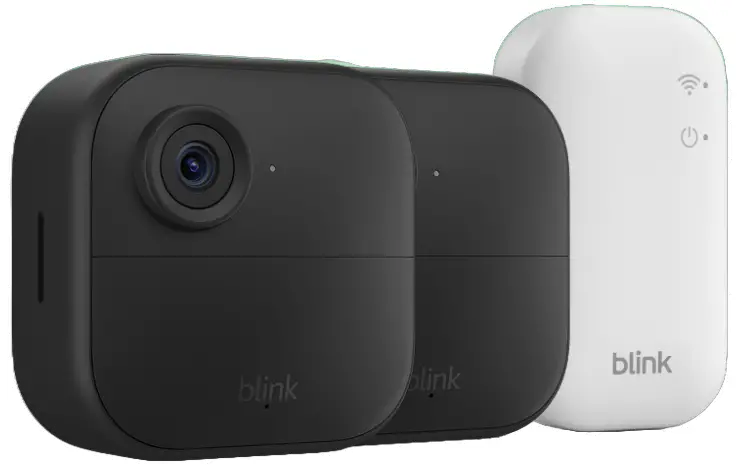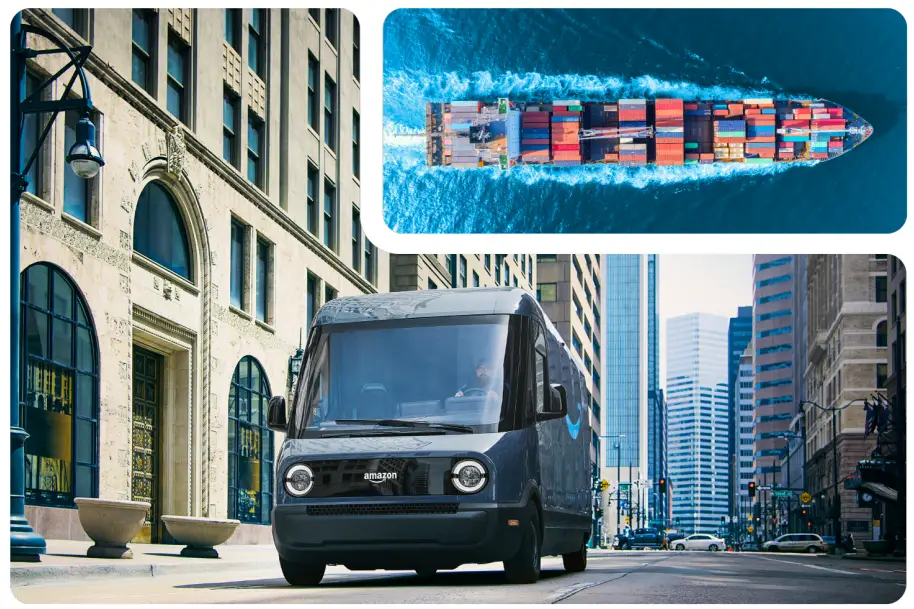Blink Outdoor 4 Sync Module Core

Know the Carbon Footprint
We measure and estimate this product’s carbon footprint, and identify opportunities to reduce its carbon emissions.
![]() Carbon Footprint
Carbon Footprint
40 kg CO2e total carbon emissions
Materials
Made from 16% recycled materials. The plastic in this device is made from 35% post-consumer recycled plastic.
Energy
This device is designed with essential-only components to minimize power consumption when idle.
Trade-in and Recycle
Built to last. But when you’re ready, you can trade-in or recycle your devices. Explore Amazon Second Chance.
Figures are for Blink Outdoor 4 (two-cam) + Sync Module Core, not including any other versions or any bundled accessories or devices. We update the carbon footprint when we discover new information that changes the estimated carbon footprint of a device by more than 10%.
![]() This device is a Climate Pledge Friendly product. We partner with trusted third-party certifications and create our own certifications like Compact by Design and Pre-owned Certified to highlight products that meet sustainability standards.
This device is a Climate Pledge Friendly product. We partner with trusted third-party certifications and create our own certifications like Compact by Design and Pre-owned Certified to highlight products that meet sustainability standards.
![]() The product carbon footprint of this device has been certified by the Carbon Trust 1.
The product carbon footprint of this device has been certified by the Carbon Trust 1.
Life Cycle
We consider sustainability in every stage of a device’s life cycle – from sourcing raw materials to end-of-life.
Blink Outdoor 4 (two-cam) + Sync Module Core total life cycle carbon emissions: 40 kg CO2e

Comparison Against Baseline
To assess this device’s carbon footprint, we compare its emissions to a baseline device: Blink Outdoor 4 (two-cam) + Sync Module 2. This helps us track our progress in reducing this device’s carbon footprint.
Life Cycle Carbon Emissions (kg CO2e)
![]() Blink Outdoor 4 (two-cam) + Sync Module 2
Blink Outdoor 4 (two-cam) + Sync Module 2
![]() Blink Outdoor 4 (two-cam) + Sync Module Core
Blink Outdoor 4 (two-cam) + Sync Module Core

Life Cycle Assessment: A methodology to assess the environmental impact (e.g., carbon emissions) associated with life cycle stages of a product—from raw material extraction and processing, through production, use, and disposal.
This product’s biogenic carbon emissions of -0.195 kg CO2e are included in the total footprint calculation. The total biogenic carbon content in this product is 0.129 kg C. Percentage values may not add up to 100% due to rounding.
Materials and Manufacturing
We account for the extraction, production, and transportation of raw materials, as well as the manufacturing, transporting, and assembling of all parts.
Recycled Materials
This device is made from 16% recycled materials.
The plastic in this device is made from 35% post consumer recycled plastic (resin from battery not included). We incorporate recycled fabrics, plastics, and metals into many new Amazon devices, giving new life to materials. Bundle accessories not included.
Recyclable Packaging
This device has 100% recyclable packaging. 99% of this device’s packaging is made of wood fiber based materials from responsibly managed forests or recycled sources.
Chemical Safety
Through our partnership with Chem FORWARD, we’re collaborating with industry peers to proactively identify harmful chemicals and safer alternatives ahead of regulations.
Suppliers
We engage suppliers who manufacture our devices or their components—particularly final assembly sites, semiconductors, printed circuit boards, displays, batteries, and accessories—and encourage them to increase renewable energy use and reduce manufacturing emissions. To date, we have received commitments from 49 key suppliers to work with us on decarbonization, and helped 21 of them develop renewable energy implementation plans for Amazon Devices production. We are continuing to expand this program in 2025 and beyond.

Transportation
We account for an average inbound and outbound trip that is representative of an average device or accessory. Inbound trip includes transporting the product from final assembly to Amazon warehouses while outbound trip includes transporting the product from warehouses to the customer.
Amazon Commitment
Delivering for our global customers requires Amazon to rely on a variety of transportation solutions for long and short distances. Over the lifetime of the device, Amazon will ship at least 60%* of the global inbound volume of the Blink Outdoor 4 (two-cam) + Sync Module Core via non-air modes of transportation.
Diversifying Transportation Modes
Decarbonizing our transportation network is a key part of meeting The Climate Pledge by 2040. According to our science model, on average, ocean shipping emissions are approximately 95% lower than air transport emissions.
Since 2020, we’ve reduced carbon emissions from transportation of our devices by 71%. We’ve done this by prioritizing transportation via ocean and modes that are less carbon intensive than air like rail and road.

Product Use
We determine the expected energy consumption of a device over its lifetime and calculate the carbon emissions associated with the use of our devices.
Energy Efficient Design
The redesigned sync module uses energy only when in use. It is built with essential-only components and optimized software to significantly reduce power consumption, especially during idle time, while maintaining performance.

End-of- Life
To model end-of-life emissions, we estimate the ratio of end products that are sent to each disposal pathway including recycling, combustion, and landfill.
We also account for any emissions required to transport and/or treat the materials.
Durability
We design our devices with best-in-class reliability models, so they’re more resilient and last longer. We also release over-the-air software updates for our customers’ devices so they don’t need to replace them as often.
Trade-in & Recycling
We make it easy for you to retire your devices.
Using Amazon Trade-In, you can trade-in your old devices for a gift card. Your retired devices will then be either refurbished and re-sold, or recycled.

Methodology
Our approach to measuring a product’s carbon footprint?
To meet The Climate Pledge goal to be net-zero carbon by 2040, we measure and estimate this product’s carbon footprint, and identify opportunities to reduce its carbon emissions. Our life cycle assessment (“LCA”) models align with internationally recognized standards, like the Greenhouse Gas (“GHG”) Protocol Product Life Cycle Accounting and Reporting Standard 2 and International Standards Organization (“ISO”) 140673 . Our methodology and product carbon footprint results are reviewed by the Carbon Trust with reasonable assurance. All carbon footprint numbers are estimates and we continuously improve our methodology as the science and data available to us evolve.
What’s in an Amazon device’s product carbon footprint?
We calculate this product’s carbon footprint throughout its life cycle stages, including materials and manufacturing, transportation, use, and end-of-life.
Two carbon footprint metrics are considered: 1) the total carbon emissions across all life cycle stages of one device or accessory (in kilograms of carbon dioxide equivalent, or kg CO2e), and 2) the average carbon emissions per year used of the estimated device lifetime, in kg CO2e/use-year.
Materials and Manufacturing: We calculate the carbon emissions from material and manufacturing based on the list of raw materials and components to manufacture a product, namely the bill of materials.
We account for the emissions from the extraction, production, and transportation of raw materials, as well as the manufacturing, transporting, and assembling of all parts. For certain components and materials, we may collect primary data from our suppliers to supplement our industry average data, collected from a mix of commercially and publicly available LCA databases.
Transportation: We estimate the emissions of transporting the product from final assembly to our end customer using actual or best estimated average transportation distances and transportation modes for each device or accessory.
Use: We calculate the emissions associated with the use (i.e., electricity consumption) of this product by multiplying the total electricity consumption over a device’s estimated lifetime with the carbon emissions from the generation of 1 kWh electricity (the grid emission factor). The total energy consumption of a device is based on the average customer’s power consumption and estimated time spent in various modes of operation like playing music, playing video, idle, and low power mode. A specific customer may have a higher or lower use phase footprint associated with their device depending on their specific usage patterns.
We use country-specific grid emission factors to account for the regional variations in electricity grid mix. Learn more about how Amazon plans to decarbonize and neutralize the use phase of our connected devices by 2040.
End-of-Life: For end-of-life emissions, we account for any emissions required to transport and/or treat the materials destined to each disposal pathway (e.g., recycling, combustion, landfill).
How do we use the product carbon footprint?
The footprint helps us identify carbon reduction opportunities across this product’s various life cycle stages. In addition, we use it to communicate our carbon reduction progress over time—this is included in the calculation of Amazon’s corporate carbon footprint. Learn more about Amazon corporate carbon footprint methodology.
How often do we update a product’s carbon footprint?
After we launch a new product, we track and audit the carbon emissions of all life cycle phases of our devices.
Product sustainability fact sheets are updated when we discover new information that changes the estimated carbon footprint of a device by more than 10% or if it materially changes our estimated reduction generation over generation.
Learn more about our product carbon footprint methodology and limitations in our full methodology document.
Definitions:
Biogenic carbon emissions: Carbon released as carbon dioxide or methane from combustion or decomposition of biomass or bio-based products.
Life Cycle Assessment: A methodology to assess the environmental impact (e.g., carbon emissions) associated with life cycle stages of a product—from raw material extraction and processing, through production, use, and disposal.
Endnotes
- Carbon Trust Certification Number: CERT-13795; LCA data version 14 March 2025. This device has a reduced carbon footprint compared to a baseline device.
- Greenhouse Gas (“GHG”) Protocol Product Life Cycle Accounting and Reporting Standard: https://ghgprotocol.org/product-standard published by the
Greenhouse Gas Protocol - International Standards Organization (“ISO”) 14067:2018 Greenhouse gases—Carbon footprint of products—
Requirements and guidelines for quantification: https://www.iso.org/standard/71206.html published by International Standards Organization

Documents / Resources
 |
Blink Outdoor 4 Sync Module Core [pdf] User Manual Blink Outdoor 4, Sync Module Core, Outdoor 4 Sync Module Core, Outdoor 4, Sync Module Core, Module Core, Core |